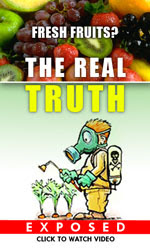Idiocracy: Food Packaging Should Have Traffic Light Labels?
![]() Heather Callaghan, Guest
Heather Callaghan, Guest
Waking Times
The main character in the movie Idiocracy goes to the hospital of the future and tries to tell the clerk about his problem. She apathetically scans her finger over a bunch of picture buttons that indicate a medical problem – she doesn’t have to think. Imagine if everything was even further reduced from Idiocracy into nothing but basic colors and shapes. It would almost be like shopping with Big Bird as your guide.
“Should food products be labeled with traffic light symbols to make health-related information on ingredients easier to understand?”
Apparently, this very topic has been up for debate…according to researchers at the University of Bonn. This writer would like to show you that this is really only yet another study that benefits Big Food, not the obesity-ridden consumer.
As you may have guessed – they’ve decided that Americans would respond better to traffic light labels to resist foods the researchers deem as “bad” – that is, high-calorie foods and foods that contain unspecified levels of salt, sugar and fat..
In a study recently published in the journal Obesity, researchers observed brain scans of participants making food purchasing decisions.
A press release explains:
Red, yellow, green: The traffic signal labels on packages are supposed to be an easy-to-understand indication of the overall “healthiness” of a food product. For example, “red” symbolizes a high percentage of fat, sugar or salt, “green” a lower percentage. Just as on an actual traffic light, yellow falls in the middle. ” This is the first study that analyzes the effect that traffic light signals have on the evaluation processes in the consumer’s brain when making a purchase decision”, says Prof. Dr. Bernd Weber of the Center for Economics and Neuroscience (CENs) at the University of Bonn. Do the “traffic lights” help consumers choose a healthier diet when grocery shopping? Scientists from the CENs have addressed this question in a recent study.
“The traffic light label appears to enable the study participants to better resist unhealthy foods compared to a label containing the traditional information on grams and percentages of the particular ingredients. A traffic light label probably implicitly increases the weight consumers place on healthiness in their decision”, says Prof. Weber, summarizing the result.
For starters, who gets to decide what is “healthful”? The same league of researchers who always have and who have been wrong before and who have deemed food chemicals as safe. Will coconut oil, avocados and sea salt all receive “red” stickers and considered “bad”?
Has this plate helped kids stuck eating school cafeteria meals? Has it helped reduce obesity and increase nutritional choices? No? That’s because there are other factors involved with nutrition such as economics and regional food disparity.
But here’s the part of the study that was a “red” flag for me…
Then participants had to indicate how much they were willing to pay for a particular product.
The participants were willing to pay significantly more money for the same product when the traffic light label was “green” compared to an information-based label.
“You can conclude that the traffic light label acts as a reinforcer: The health relevance of the ingredients is weighed more heavily into purchasing decisions compared to simple nutrition information”, says first author Laura Enax of CENs. They used color on the brain’s primal and reward systems. Why think about what you are eating when a color can trigger a manufactured self-control?
 Is this really a matter of best marketing practices? Science really seeks to know you inside and out – and what will make you buy or believe.
Is this really a matter of best marketing practices? Science really seeks to know you inside and out – and what will make you buy or believe.
At this point in time, I don’t necessarily blame the consumer for obesity, but industry-backed science for giving the “green light” to chemicals, ingredients and packaging like BPA known to cause obesity all along. Seriously, the toxic food packaging alone is enough to make every packaged food item deserve a red sticker. Or take the medical practice of handing out antibiotics for everything and its plumping results.
How can consumers trust the same conglomerate responsible for heralding corporate chemical laden food that is now supposedly trying to help with obesity. They have profited off the study of obesity for decades – is the idea really to end it? Should they be the ones who decide what is healthy for you?
Now they want to further insult people with green, red and yellow stickers better reserved for children’s public television.
One could easily think I’m going too far, but any trust in the same scientific process that brought us where we are now is long gone. This is not only a most ridiculous attempt to get people to further give up their ability to think under a scientific dictatorship, but a boon for corporate food giants who would flourish under this label technique. One could also further say good-bye to any attempts for GMO labeling in the U.S. if this idea were to catch on. On the plus-side (no pun intended) – it would still beat the idea of the negative reinforcement that involves pictures of obesity diseases on packaging – like cigarette packages in some countries that are meant to induce shame.
 Publication: Nutrition labels influence value computation of food products in the ventromedial prefrontal cortex, “Obesity”, 10.1002/oby.21027
Publication: Nutrition labels influence value computation of food products in the ventromedial prefrontal cortex, “Obesity”, 10.1002/oby.21027
About the Author
Heather Callaghan is a natural health blogger and food freedom activist. You can see her work at NaturalBlaze.com and ActivistPost.com. Like at Facebook.
**This article was featured at Activist Post.**
©2015 Waking Times, all rights reserved. For permission to re-print this article contact wakingtimes@gmail.com, or the respective author.
~~ Help Waking Times to raise the vibration by sharing this article with friends and family…